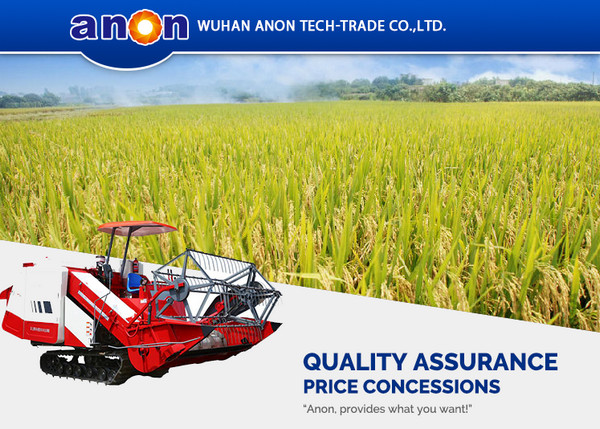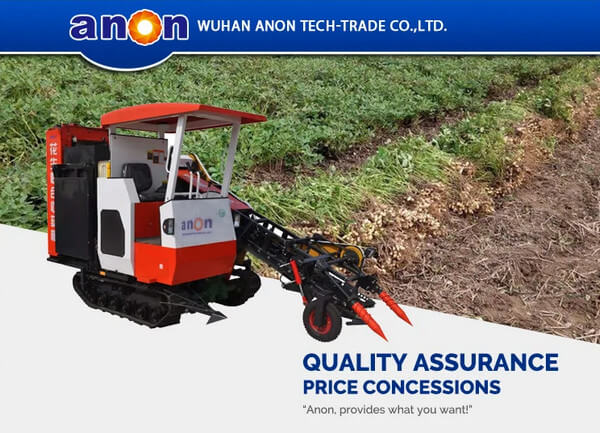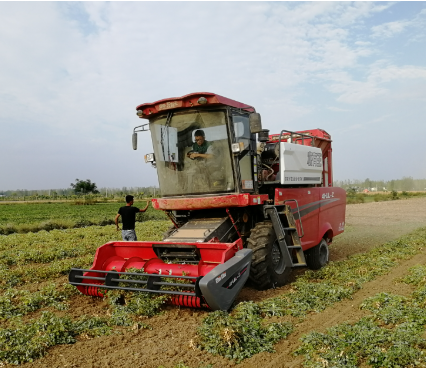Introduction
Do you want to quickly solve the problem of forage harvesting and feed production? Forage harvesters can help you complete these tasks! In modern agriculture, farmers use silage harvesters to efficiently harvest and make silage feed, saving valuable time. Follow me today to learn about silage harvesters!
What does a forage harvester do?
Harvest and produce silage
A forage harvester is an agricultural machine designed to efficiently gather silage crops like corn, forage, and sorghum, also known as a silage harvester. Its main purpose is to produce silage feed. When working, it first harvests the crops and then crushes them to a length suitable for livestock digestion and absorption. The crushed crops can then be directly put into the silage pit or silage bag for sealed fermentation and storage. Silage feed is rich in nutrients. It is processed when the water content of the forage is high (65-75%). It has a sour and fragrant smell, is soft and juicy, and is the staple food of ruminants. Its nutritional content is higher than that of dry feed, and it can be stored for a long time. In winter or the dry season, it can help you solve the problem of a shortage of green feed for farm animals.
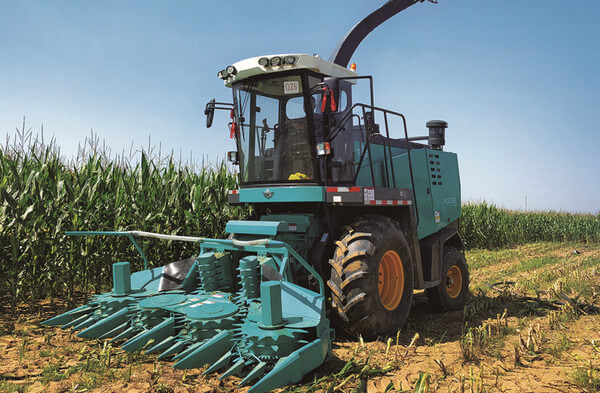
Other crop handling
Forage harvesters are widely used and can flexibly handle the harvesting of various crops, whether they are upright crops like corn and sorghum or root crops like sweet potatoes and pumpkins. They can efficiently harvest crops. They are highly adaptable and can easily cope with different terrains and field conditions, making them a good helper for farmers.
How a Forage Harvester Works?
When the forage harvester enters the field, it makes a loud noise, the crops touch the cutting platform and move to the air intake, the feed roller pushes the crops in and crushes them, and then the rotating blade cuts the crops into suitable lengths. For crops containing grains such as corn, you can add a grain-crushing device to crush the grains and maximize the nutrition of the feed. The machine then uses a fan and a throwing drum to send the chopped crops to the transport vehicle. The main working parts of the forage harvester are the header, the feeding system, the crushing device, and the throwing device.
Main Components
Cutting Platform
First up is the header. The main working part of a forage harvester is located at the front of the machine and usually consists of two large discs that cut the incoming crop.
Feeding System
Then, there is the feed system, which consists of five feed rollers that are responsible for feeding the crop into the machine and crushing it.
Cutting System
The shredding system uses flat roller knives arranged in a “V” shape. This setup cuts the crop more evenly.
Throwing device
Finally, there is the throwing system, which consists of a powerful fan and an extended throwing drum to throw the chopped feed into the loading truck.
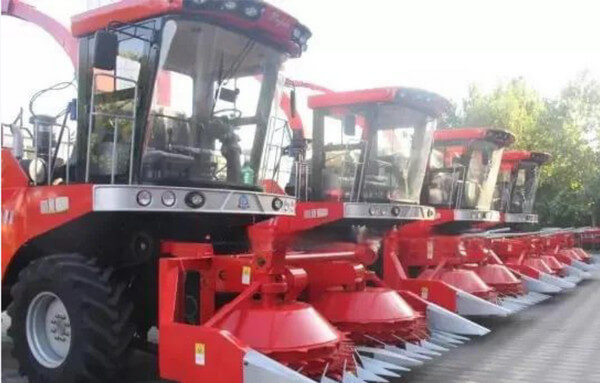
Types of Forage Harvesters
Forage harvesters can be self-propelled, tractor-mounted, or trailed harvesters.
Self-propelled forage harvesters
A self-propelled forage harvester is harvesting equipment with its own power system and walking device, specially used for harvesting silage crops such as corn, alfalfa, oats, etc. Its operation process includes cutting, chopping, throwing, etc., realizing integrated harvesting and processing, and it is suitable for crops of different maturity and types. The self-propelled forage harvester is equipped with a double-disc vertical drum cutting device. The high-speed rotating blade cuts the straw and sucks it into the casing. After multiple collisions and rubbing, it is sent to the transport vehicle by the throwing device. The self-propelled silage harvester is suitable for large farms, pastures, farms and other places that require efficient harvesting.

Tractor-mounted forage harvesters
A tractor-mounted forage harvester is a kind of agricultural machinery used in conjunction with tractors, mainly used for harvesting crops such as wheat, corn, and forage. By using it in conjunction with a tractor, the mounted silage harvester can significantly improve the utilization rate of the tractor, making it more flexible and convenient to operate. The mounted design is usually cheaper, which reduces the purchase cost of the machine for farmers.

Pull-type forage harvesters
Operate a pull-type forage harvester with a tractor to complete silage operations through traction. The towed silage harvester is suitable for crushing and harvesting various standing dry and fresh crop stalks, such as corn stalks, forage grass, and other plants, to meet the harvesting needs of different crops. The towed silage harvester is usually designed to be compact and easy to operate in various complex terrains. It is particularly suitable for large-scale silage feed harvesting operations.

Advantages of the forage harvester
Efficient harvesting of silage crops
When harvesting crops, the forage harvester cuts them into lengths suitable for processing. Some forage harvesters have grain-crushing devices, which are particularly useful for processing corn. It also has a throwing function to load the feed onto the vehicle. This versatile design allows the forage harvester to complete multiple tasks in one operation, thereby improving efficiency and reducing the need for additional labor and resources. Helping to reduce physical labor, it greatly improves the efficiency and productivity of harvesting, helping you harvest more crops in a shorter time.
By changing or adjusting the cutting deck and chopping equipment to handle different types of forage crops, such as sorghum, alfalfa, and grains, you can harvest a variety of crops in different seasons and greatly increase their availability.
Improve feed quality
The forage harvester harvests and chops crops while they are still green for sealed fermentation. Its precise cutting mechanism ensures the optimal crop length of the silage, thereby improving the overall nutritional quality. Compared with manual and traditional harvesting equipment, the silage harvester can reduce the loss and pollution of crops during cutting and transportation. It can cut the whole plant, ensuring that all parts of the crop are used without wasting any part. So it can greatly improve the effective recovery rate of farmland crops and ensure the health of the feed eaten by farm animals.
Advanced Technology
No-row-spacing harvesting technology: No-row-spacing harvesting is suitable for crops with different planting densities.
Safety protection tech: The machine has a safety clutch and spit-out device. If crops overfeed and block, the device spits them out to resume normal harvesting.
Unique header design: The adjustable-height reel on the header lets operators set the perfect cutting position. This ensures smooth cutting, even for lodged silage crops, significantly boosting harvest efficiency.
Save Money
A forage harvester can bring you long-term cost savings and efficiency gains.
First, it helps reduce labor costs — no more relying on manual harvesting or chopping grass and crop stalks. With mechanized operation, the process is much faster: what goes in is grass or straw, and what comes out is ready-to-use silage. Second, the silage processed by the machine is of excellent quality, with higher nutritional value, making it better for feeding farm animals.
Although purchasing a silage harvester does require a significant upfront investment, it is undoubtedly a worthwhile deal in the long run — a reliable, cost-effective choice for sustainable farm operations.

Common Problems and Solutions
Cutting is not smooth
During the mowing process, you may encounter a situation where the cutting is not smooth, resulting in low efficiency. This may be the reason for the blunting, wear, or lack of blades, improper adjustment of the blade gap, or excessive or insufficient feeding, resulting in smooth cutting or even blockage. If the blade is blunt or damaged, you want to sharpen or replace the blade in time. Adjust the blade gap according to the crop conditions; a setting of 0.1–0.3 mm is typically optimal. During operation, control the feeding rate to prevent overloading or underfeeding, ensuring consistent material flow.
Uneven feeding
Uneven feeding may cause uneven crop cutting lengths, which may affect the quality of feed and even block the machine. Unstable feeding may also cause frequent starts and stops of the machine, causing increased wear and affecting operating efficiency. In this case, you can properly adjust the pressure of the feed roller to ensure that the material is transported stably. You need to control the feeding speed and clean the feed inlet and transmission system. And at last maintain stable and uniform feeding of the machine.
Short throwing distance
The forage harvester’s short-throwing distance prevents silage from reaching the designated area. Use manual labor or additional equipment to assist with silage collection. The collection difficulty increases, which increases the operation time and may also cause damage to the silage. In this case, you need to consider whether the throwing plate is improperly adjusted or there is a grain blockage in the grain thrower. It is generally best to adjust the angle of the throwing plate to about 20 degrees, which can usually effectively improve the throwing distance of the grain. If the throwing barrel is blocked, the grain thrower needs to be cleaned. Especially the throwing parts and channels, to remove residues and dust. Replace the wind plate to adjust the wind force and solve the problem of poor grain throwing.
Abnormal vibration of the machine
When the forage harvester shakes abnormally, you should first check whether it is due to improper operation. Such as unreasonable speed control or incorrect working angle of the harvester, and adjust the speed and working angle accordingly. If it is not related to the operation, you need to stop the machine for a more detailed inspection.
First, determine whether it is a problem with the gearbox, check the wear of the rolling bearings and transmission gears, and if there is a problem, replace the rolling bearings or transmission gears. Secondly, it may also be a problem with the engine. You need to check whether the engine and control system are working properly and make corresponding adjustments, such as re-adjusting the idle power switch, replacing new sensors, etc. There may also be a problem with the shift lever and fork slot connection being loose. At this time, you need to re-fix or replace the shift lever or fork slot.

Maintenance Tips
Daily inspection of parts
Regularly check whether the bolts, nuts, washers, etc., of various parts are loose or missing, especially the fasteners of key parts such as the header, conveyor trough, and roller, and lubricate them regularly to avoid malfunctions during use. You should also check the blades, transmission chains, belts, bearings, and hydraulic systems every period of time. These key components directly affect the working effect of the harvester. Replace worn blades promptly, adjust or replace loose transmission chains and belts, replace bearings that overheat or make abnormal noises, and regularly check the hydraulic oil level in the system. Additionally, inspect tire pressure and wear frequently. If necessary, inflate or replace the tires in time.
Avoid overload
Although the silage harvester is a large agricultural machine, we should also avoid overloading it during use.
First, overloading will cause the internal parts of the harvester to bear excessive pressure and friction, accelerating wear on parts such as the cutting blade, transmission chain or belt, and the two key parts of bearing parts will wear faster, shortening the service life.
Secondly, machine overload will also affect the performance and efficiency of the machine. Overloading the machine overstresses the engine and transmission system. This reduces power output, lowers operating efficiency, and degrades silage quality. Finally, the safety hazards and maintenance costs caused by overload will also increase. Overload will make the machine difficult to operate, the engine may stall, frequent starts and stops will pose a safety threat to the operator, and the frequency of maintenance will also increase.
Regular Clean
Clean both the inside and outside of the silage harvester during fieldwork. When cleaning the harvester, you first need to remove the debris on the surface, such as dirt, grass clippings, straw, etc. Use a broom, brush, air pump, etc., to clean the harvester. Turn off the harvester before cleaning to prevent accidents. Next, disassemble the cutter to remove dirt and grass from the blade. Clear the residue from the conveyor trough to ensure smooth operation.
Conclusion
I believe that through the introduction of this article, you have a certain understanding of silage harvesters. For 20 years, ANON has had 20 years of experience in agricultural machinery, and our aim is to deliver high-quality, cost-effective solutions to customers. ANON is always by your side.
FAQ
Why do we need a forage harvester?
A forage harvester provides an effective feed-processing solution for your farming needs. Its multifunctionality, adaptability, and high level of automation make it an essential piece of equipment in modern agriculture.
What is the difference between a harvester and a feed harvester?
Although harvesters typically refer to machines that collect and process crops, feed harvesters are specifically designed for cutting and processing feed crops such as grass and corn. The particularity of the feed harvester makes it an indispensable tool for farmers to handle silage production.
What is the most popular forage?
Forage maize, aside from grass, is the most widely grown forage crop, popular for its high starch content, the majority being used for livestock but an increasing proportion being used for biogas production.


